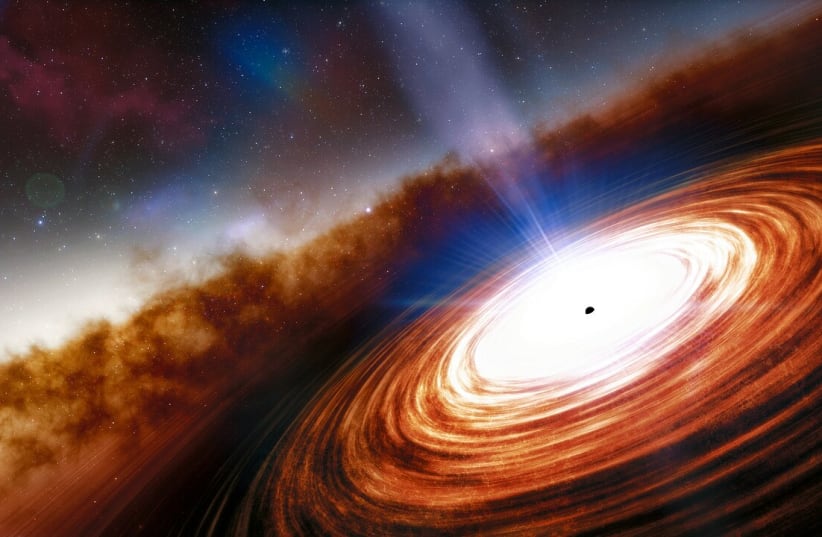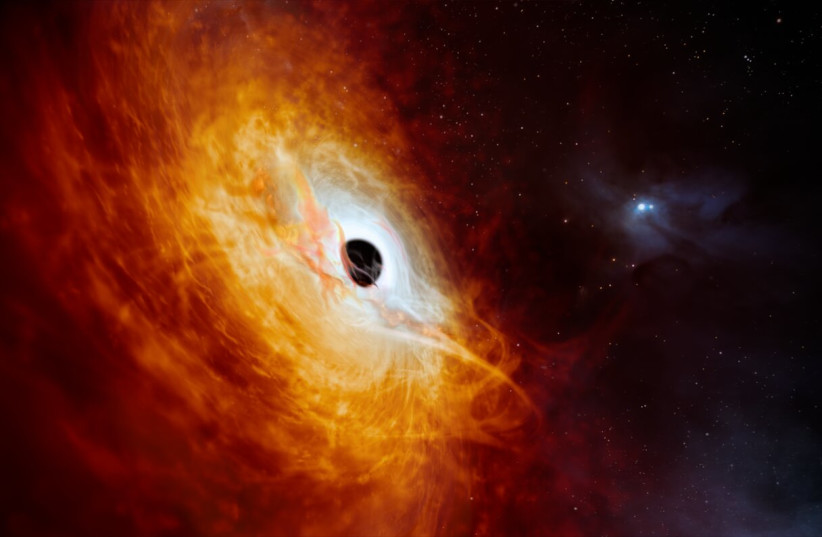Researchers find 'excessively' large red supermassive black hole in early universe - study
A large and red supermassive black hole was found in a distant galaxy during the early years of the universe is excessively big for its galaxy, raising more questions about early galaxy formation.
An Israeli-led group of researchers have discovered an unusually large and extremely red supermassive black hole and quasar at the center of a galaxy far off in the early universe, according to a recent study.
The researchers, led by Dr. Lukas Furtak and Prof. Adi Zitrin from Ben-Gurion University of the Negev, were able to make this discovery thanks to NASA's James Webb Space Telescope (JWST) as well as a technique known as gravitational lensing.
The findings of this study were published in the peer-reviewed academic journal Nature, and contribute to the growing number of JWST-powered studies of galaxy formation in the early days of the universe.
In the shadows of the early universe, a red supermassive black hole grew with a galaxy around it
Despite the ominous reputation of black holes, one well-deserved since they consume everything unfortunate to come close to it, supermassive black holes play a very important role in the universe. This is because most galaxies, including our own Milky Way, have one such black hole at its center.
These supermassive black holes sit are surrounded by huge collections of minerals and gasses called accretion discs, which it slowly pulls into itself and consumes.
Galaxies with particularly large accretion discs consequently have very active supermassive black holes at the center and become known as active galactic nuclei (AGN). Especially bright AGNS are known as quasars, and are some of the brightest things in the universe. In fact, they are so bright they are often mistaken for stars.
The researchers behind this latest study were able to use JWST images to find one such quasar.
Originally, the images in question were taken by JWST for the UNCOVER program and showed a cluster of galaxies known as Abell 2744.
But thanks to the galaxy cluster, the researchers were able to see light from the galaxies behind it.
This was because of gravitational lensing, a natural phenomenon in which the gravity of a massive body, such as a galaxy or a galaxy cluster, bends the light that is being emitted from a distant object. This allows the gravity of the massive object to act like a lens, and through this method, the light of the distant object is intensified and its shape is enlarged.
Basically, if we on Earth want to see Galaxy A, but Galaxy B is in the way, then the sheer mass and gravity of Galaxy B might be able to help by bending the light from Galaxy A so we'd be able to better look at it.
In this case, behind Abell 2744 was three red dots, which they realized was a quasar or something like it.
"We used a numerical lensing model that we had constructed for the galaxy cluster to determine that the three red dots had to be multiple images of the same background source, seen when the Universe was only some 700 million years old," Zitrin said in a statement.
The "red" color has to do with redshifting, a measure of speed that can be used to gauge distance. Basically, the light wavelength is stretched, and this makes the light appear to be redder.
When the reverse happens, the light will appear to be bluer – a phenomenon is known as blueshift.
This is very similar to the Doppler effect, the phenomenon when a sound changes depending on direction.
This was all known last year in a study published in the Astrophysical Journal. But what's new here is the JWST data about the black hole by analyzing the spectrum of light. And what the researchers found was very surprising.
To make a long story short, the supermassive black hole is, well, super massive - excessively so compared to the mass of the galaxy around it.
"All the light of that galaxy must fit within a tiny region the size of a present-day star-cluster. The gravitational lensing magnification of the source gave us exquisite limits on the size. Even packing all the possible stars into such a small region, the black hole ends up being at least 1% of the total mass of the system," as explained by Princeton University's Prof. Jenny Greene, one of the study's lead authors.
She further explained that this isn't wholly unique, because plenty of other supermassive black holes in the early universe have been shown doing something similar.
But this raises a very big question: Where did they come from?
Black holes are formed when stars go supernova and die. Supermassive black holes are thought to grow from stellar remnants as well. But this cycle takes a lot of time, and it not enough time in the universe's existence would have passed for enough stars to have died and form supermassive black holes and subsequently form such massive galaxies.
It's why some researchers have suggested that black holes were actually around since the dawn of time, perhaps forming in the universe's earliest days along with stars.
"In a way, it's the astrophysical equivalent of the chicken and egg problem," Zitrin said. "We do not currently know which came first – the galaxy or black hole, how massive the first black holes were, and how they grew."




No comments:
Post a Comment